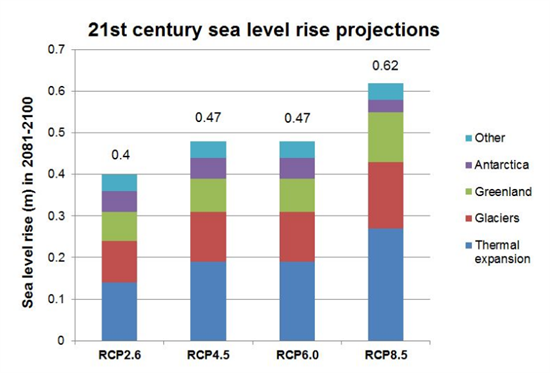In Part 2 of the round-up of commentary on the IPCC WG1 report I’ve tried to highlight where people have said something new or not emphasised elsewhere. I’ve not attempted to cover the MSM.
That’s it as a round-up. I plan to revisit particular topics later when the IPCC have finished fiddling with the text and layout.
The following image is the temperature projections representing the most optimistic and pessimistic scenarios. Bear in mind that RCP2.6 is probably hopelessly optimistic and at present we are tracking to do worse than RCP8.5. Also what happens is not likely to be as smooth as the graphs the models spit out.

Here’s the link to Part 1.
The New Scientist has a special on the IPCC report which appears not to be paywalled at least yet. Among the questions asked is, can we be sure that any big issues have been missed?
Not entirely, is the answer given, but the text really says, yes, we can be sure. Anything that can’t be well-measured, such as the leaking of methane from permafrost, has been set aside. Also impacts with low probability and higher threat. So the report is restricted to the well-understood knowns and thereby conservative.
Science writer Michael Le Page distils a 10-word bottom line: we have to leave most fossil fuels in the ground.
He points to Norway to illustrate the problem. They get nearly 60% of their electricity from renewable sources and plan to go carbon neutral by as early as 2030. But they will do this by buying carbon credits with the earnings of their fossil fuel exports.
Doug Craig at Climate of Change picks up on the theme. Energy companies are currently spending $600 billion trying to find more fossil fuels.
The Conversation has tagged a topic IPCC Fifth Assessment Report
Kevin Trenberth thinks the IPCC should declare success and make this the last of the reports compiled by the current method. Six years is too long, the voluntary work involved too burdensome. We need more flexible, responsive ongoing climate information services.
Andrew Glikson talks about tipping points and says insufficient attention is paid to them. Fires are still poorly represented in global models. Natural and anthropogenic forest and bushfires release 2 to 4 gigatonnes of carbon per year.
Katherine Bagley at Inside Climate News picks up on Trenberth’s point about reforming the IPCC, making definite suggestions. In brief, publish smaller, more frequent, more targeted assessments, with more transparency and with better co-ordination in the release of technical reports.
Alex Kirby of Climate News Network says one key finding of the report has attracted fewer headlines than it deserved, namely that the world had already used between half and two-thirds of its “carbon budget”. From his account Su Wei, China’s chief climate change negotiator and director general of the department of climate change of its National Development and Reform Commission (NDRC), does seem to be well aware of the situation, which could help.
Simon Lauder at the ABC RN’s The World Today looks at possible business reaction. James Day, director of CDP (Carbon Disclosure Project) which provides investors with information about how companies are responding to climate change, says:
The way that the IPCC report has framed these targets, in terms of an absolute amount of emissions that can be emitted over the next few decades, is new. And that will also have to flow through to the sorts of budgets that countries and companies set all around the world.
Day says they currently advise over 722 institutional investors globally, representing over $80 trillion in assets, which is an significant increase from last year.
Also from ABC Online John Connor of the Climate Institute says the IPCC report shows the Coalition needs to rethink carbon reduction targets. Australia has ignored climate action being taken in China and the US.
Also:
The independent Climate Change Authority is expected to deliver its review of emissions targets next month.
In a leaked draft earlier this year, it flagged the possibility of a trebling of the 5 per cent [2020] target and a 40 per cent cut by 2030.
Freya Roberts at The Carbon Brief looks at sea level rise and comes up with this graph from the text:

The first thing to note that the graph represents midpoints, not the worst case for each scenario. Secondly, as with the text the time frame is 2081-2100, effectively 2090 rather than 2100. Third it’s clear that the ice sheets are expected to play a minor role. The big surprise could come from Antarctica, where the ice is directly exposed to warming sea water, and giant glaciers, such as Pine Island.
Freya points out that there was a six-fold increase in ice loss from Greenland during the decade 2002-2011.
The Griffith Climate Change Response Program will conduct a lunchtime seminar on the IPCC report at Southbank, Brisbane on Tuesday 15 October. The speaker will be Prof Nathan Bindoff of the University of Tasmania.
I thought I’d end this post with the following image, just because it appealed to me:

It comes from Doug Craig’s blog Climate of Change.

Brian
Thanks for this – drawing attention to issues not covered in MSM discussion.
Doug, I avoided also all the skeptic/denialist carping in line with my policy of not giving them any more oxygen.
Having used half to two thirds of the carbon budget vs $600 billion on exploration for fossil fuels puts that “choice of catastrophes” in perspective doesn’t it. I cannot see fossil fuel companies wanting anything other than a massive return on that investment. So how much of that 800 to 1500 Bn tonnes of co2 would bring a reasonable return for them?
I think one of the tipping points we need to deal with/publicise is when the exploration budget is such that it guarantees blowing the carbon budget. that could be a good point to publicise.
Cheers Brian.
Thanks Jules, good point!